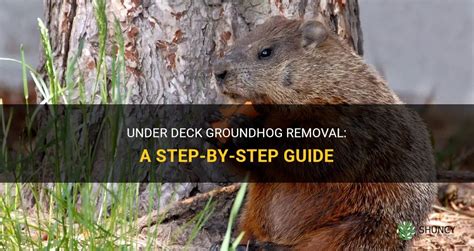Groundhogs, also known as woodchucks, are common pests that can cause significant damage to gardens, lawns, and even structures. If you’ve discovered a groundhog under your deck, it’s important to take prompt action to remove it and prevent future infestations.

Why Groundhogs Dig Under Decks
Groundhogs are burrowing animals that seek shelter from predators and inclement weather. The underside of your deck provides an ideal nesting spot, offering protection from the elements and predators. Additionally, groundhogs may be attracted to the warmth and moisture that can accumulate under decks, especially during the winter months.
Dangers of Groundhogs Under Decks
While groundhogs are not typically aggressive towards humans, they can pose several hazards:
- Property Damage: Groundhogs can burrow under your deck, damaging its supports and causing it to collapse. They can also chew on electrical wires and other utilities, creating a fire hazard.
- Health Concerns: Groundhogs can carry diseases such as rabies and Lyme disease. Their droppings can also contaminate soil and plants, posing a health risk to humans and pets.
- Nuisance Behavior: Groundhogs can be noisy, creating a disturbance with their digging and vocalizations. They can also damage gardens and lawns by eating plants and vegetables.
How to Remove a Groundhog Under Your Deck
If you’ve confirmed that a groundhog is residing under your deck, there are several methods you can use to remove it:
1. Trapping
Trapping is an effective way to remove groundhogs, but it’s important to use humane traps that minimize the risk of injury or death. Live traps are recommended, as they allow you to release the groundhog in a different location.
2. Fencing
Installing a fence around your deck can prevent groundhogs from digging under it. The fence should be at least 2 feet high and buried at least 6 inches underground.
3. Exclusion
Exclusion involves blocking off all entrances to the groundhog’s nesting area under your deck. This can involve sealing holes with wire mesh or concrete, and removing any objects that provide cover, such as woodpiles or debris.
4. Repellents
Repellents can be used to deter groundhogs from nesting under your deck. Commercial repellents containing capsaicin or castor oil are effective in some cases. Natural repellents, such as mothballs or peppermint oil, can also be tried.
Preventing Groundhog Infestations
Once you’ve removed the groundhog, it’s important to take steps to prevent future infestations:
- Keep Your Deck Clean: Regularly sweep or vacuum under your deck to remove food scraps and debris that may attract groundhogs.
- Seal Holes and Cracks: Inspect your deck for any holes or cracks that groundhogs could use to burrow under. Seal these openings with wire mesh or concrete.
- Eliminate Sources of Water: Groundhogs are attracted to moisture, so eliminate standing water around your deck by repairing leaks and removing birdbaths.
- Use Repellents: Commercial or natural repellents can help deter groundhogs from approaching your deck.
Safety Precautions
When dealing with groundhogs, it’s important to follow these safety precautions:
- Wear Gloves and Mask: Groundhogs can carry diseases, so always wear gloves and a mask when handling them or cleaning up their droppings.
- Avoid Direct Contact: Do not attempt to touch or handle a groundhog directly. If the animal is aggressive, contact a professional wildlife removal service.
- Dispose of Carcasses Safely: If a groundhog dies under your deck, wear gloves and a mask when removing its carcass. Dispose of the carcass properly in a sealed plastic bag.
Conclusion
Groundhogs under decks can be a nuisance and a hazard, but they can be removed and prevented with the proper strategies. By following the steps outlined in this guide, you can protect your deck and prevent future groundhog infestations. Remember to prioritize safety and seek professional assistance if necessary.
